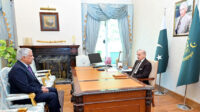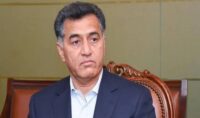By Major (R) Haroon Rasheed is a Defense and Strategic Analyst specializing in South Asian military dynamics, deterrence strategy, and defense modernization. He is a member of the Research and Evaluation Cell for Advancing Basic Amenities and Development (REC ABAD).
The Dubai Airshow, one of the world’s most anticipated aerospace events, once again brought together global aviation and defense giants showcasing the very best in commercial, military, and technological innovation. But amid the noise of roaring engines and glittering displays, a few moments stood out sharply — especially for South Asian observers. From India’s underwhelming Tejas display to Pakistan’s confident presentation of the JF-17 Block III, the contrast could not have been more striking.
Kate Winslet Says Women Are ‘Conditioned to Fear Aging’ — Opens Up About Body Confidence at 50
Ajit Doval Invited Bangladesh NSA Khalilur Rahman to Delhi
Lahore High Court Bars Police from Harassing Noor Bibi and Her Husband
For more such Opinions & Blogs, click here.
Jetline Marvel’s Coverage and the Tejas Oversight
A key observation came from aviation media platform Jetline Marvel, known for its detailed reporting and wide-ranging coverage of defense and commercial aviation. Interestingly, while it highlighted several notable aircraft participating in the Dubai Airshow, its analysis did not mention India’s HAL Tejas.
Whether this omission was intentional or simply a reflection of the aircraft’s limited presence, it certainly raised eyebrows — especially among those who expected India to push for strong visibility after recent promotional efforts for Tejas on the export front.
Tejas: Static Display Only — and Without Weapons
Adding to the curiosity, the Indian Air Force brought the Tejas only for a static display, with no weapons, no guided munitions, and no demonstration flights. For a fighter aircraft that India claims as its flagship indigenous platform, the absence of an armed configuration or aerial performance did not help its image. Delegates from various countries noted this quietly, but clearly — an airshow is where aircraft are expected to demonstrate power, not merely stand parked.
Embarrassing Incident: Hydraulic Fluid Leak Goes Viral
Matters turned worse when a video went viral, showing hydraulic fluid leaking from the Tejas during ground handling. In the high-profile, prestige-oriented environment of Dubai, such incidents spread quickly and shape impressions even faster.
Twitter went down along with chunk of internet due to Cloudflare glitch, now resolved
Afghan Trade Minister Nooruddin Azizi will visit India
PM Shehbaz Inaugurates New Shalimar Express, Highlights Pakistan’s Rail Potential in Central Asia
For many defense observers, this incident echoed longstanding concerns regarding Tejas’ reliability, maintenance challenges, and integration issues — concerns that have slowed its export prospects in the past. The optics were unfortunate for India at an event where image and performance carry immense weight.
Pakistan’s Confident Showing: JF-17 Block III Makes Impact
In contrast, Pakistan’s presence was stronger and far more dynamic. Pakistan Air Force brought two JF-17 Thunder aircraft to the show:
- One for static display fully armed
- One for aerial display, showcasing maneuverability, climb rate, and high-G turns
The aircraft on static display carried a complete air-to-air and Air-to-Ground weapon loadout, including Chinese A2A missiles and Pakistan’s own precision strike munitions. Most notable was the presence of the CM-400AKG (X-2 variant) — a missile Pakistan proudly highlights as a hypersonic anti-ship and anti-surface “S-400 battery killer.”
CM-400AKG / X-2 – A Noteworthy Highlight
The CM-400AKG’s dual radar seeker — enabling it to track targets even when enemy radars are switched off — drew special attention. After the operational success during Operation Bunyan-e-Marsoos, Pakistan’s confidence in this weapon has only grown.
Experts also discussed Pakistan’s claim that the missile achieves hypersonic speeds when launched from altitudes above 25,000 feet — a capability that few nations in the region possess.
Growing International Interest in JF-17 Block III
What turned heads in Dubai was not just the aircraft but its export momentum. With Myanmar, Nigeria, and Azerbaijan already operating earlier variants, the Block III — equipped with:
PPP’s Faisal Rathore Sworn in as New AJK Prime Minister After No-Confidence Vote
UN Security Council Adopts Resolution to Deploy International Stabilization Force in Gaza
DPM in Moscow to attend SCO-CHG meeting
- AESA radar
- HMD
- Long-range A2A missiles
- Enhanced EW suite
This year, Egypt and Iraq quietly signaled their intentions to evaluate or engage further with the JF-17 Block III program. For many countries looking for an affordable, advanced, combat-proven multirole fighter, Pakistan’s offering stands out sharply.
Arab States Turning Toward Pakistan
After recent threats and regional security events, including the Qatar attacks, several Arab countries are reassessing their defense partnerships and procurement needs. Pakistan’s missile technology, UAV systems, and fighter aircraft — particularly the JF-17 — are being viewed seriously as cost-effective and reliable options.
Conclusion
This year’s Dubai Airshow subtly but clearly illustrated a shifting narrative in South Asian aerospace dynamics. While India’s Tejas struggled with visibility, presentation, and technical issues, Pakistan’s JF-17 Block III projected confidence, capability, and growing international credibility.
The message was simple: performance speaks louder than claims — and in Dubai, Pakistan’s aircraft spoke loud and clear.
For more such Opinions & Blogs, click here.
Security forces kill 15 Khwarij in KP: ISPR
Death anniversary of singer Ali Bakhsh Zahoor being observed today
Indian forces conduct house raids, searches across Kashmir Valley
India initiates new land transfer process to expand military footprint in IIOJK
Crackdowns turn life into a nightmare for Kashmiris after Delhi blast
Major (R) Haroon Rasheed is a Defense and Strategic Analyst specializing in South Asian military dynamics, deterrence strategies, and defense modernization. He is a member of the Research and Evaluation Cell for Advancing Basic Amenities and Development (REC ABAD).
Stay tuned to Baaghi TV for more. Download our app for the latest news, updates & interesting content!






